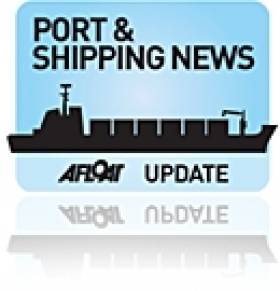Displaying items by tag: Dredger Lough Foyle
Dredging Operations Underway at Entrance to Drogheda Port
#DREDGING- Since the weekend dredging operations at the entrance to Drogheda Port on the River Boyne have begun and will continue for approximately four weeks, writes Jehan Ashmore.
Drogheda Port Company have contracted Londonderry Port & Harbour Commissioners trailer suction dredger 'Lough Foyle' to carry out dredging maintenance work at the river mouth and seaward approaches to the Boyne estuary.
The dredging operations will be carried out twice daily, approximately 4 hours before high water to 2 hours after high water. For further details of operations, the port has issued a marine notice which can be viewed under the heading 'marine' on the homepage www.droghedaport.ie/index_home.html
Lough Foyle is a 848 gross tonnes vessel which has served in Dutch waters as the former Saeftinge and was built in 1979. The 75m vessel has a hopper capacity of 850m3 /1,300 tons.
She is no stranger to the east coast port, for example in 2010 she undertook work which involved removal of sand accumulating at Drogheda Bar following a spate of south-easterly gales.
Dundalk Dredger Docked in Dublin Port Is Up for Sale
The Dublin Port Company has sought expressions from interested parties in undertaking the remaining activities of the port on an exclusive basis.
The Dundalk registered dredger arrived to the capital port on 14 July where she remains berthed at the Bulk Jetty in Alexandra Basin. Her previous owners, the Dundalk Port Company were unique in that they were the only port company to own and operate a dredger in the Republic. For many years the 757-tonnes dredger has carried out numerous contract assignments in ports throughout the island of Ireland including work on the Samuel Beckett swing-bridge and the most project was at Queens Quay, Belfast on the Lagan close to the city-centre.
Hebble Sand was launched by Richard (Shipbuilders) of Lowestoft for British Dredging and later used by Associated British Ports to serve a network of UK ports. Despite her age, the near fifty-year-old veteran vessel has been kept in excellent condition and this was evident during a rather unusual appearance for a ship of her type when attending the Dublin Docklands Maritime Festival in 2009.
She was made open for the public amongst the tall-ships that lined the Liffey Quays. Such an initiative was inspiring as it provided a rare opportunity for the public to access such a dredger which otherwise is not familiar compared to the popularity of visiting tall-ships and naval vessels.
The only other port to operate their own dredger is Londonderry Harbour Commissioners, whose Lough Foyle has worked on projects outside her homeport. This has included work at the new £40m Stena Line ferryport terminal on Loch Ryan close to Cairnryan and is due to open in November.
- Dublin Port
- Dublin Port Company
- Dundalk Port Company
- Stena Line
- Port of Dublin
- Ports and Shipping News
- Alexandra Basin
- Ferry news
- Dundalk Port
- Samuel Beckett Bridge
- Dredger Hebble Sand
- Dredger Lough Foyle
- Londonderry Harbour Commissioners
- Samuel Beckett SwingBridge
- Cairnryan ferryport
- Loch Ryan ferry terminal
- Associated British Ports
- ABP
- Richards Shipyard
- Queens Quay Belfast
- Dublin Docklands Maritime Festival 2009






























































